Variability of Water Use Efficiency Associated with Climate Change in the Extreme West of Bahia
Abstract
1. Introduction
2. Material and Methods
2.1. Study Area
2.2. Data
2.3. Methodology
2.3.1. Calculation of Water Use Efficiency (WUE)
2.3.2. Pearson Correlation Analysis
2.3.3. WUE Anomalies
3. Results
3.1. Spatial Distribution of GPP, ET and WUE
3.2. Meteorological Factors Associated with WUE Change
3.3. Spatio-Temporal Distribution of WUE Anomalies
3.4. WUE Associated with Vegetation Types
4. Discussion
5. Conclusions
Author Contributions
Funding
Acknowledgments
Conflicts of Interest
References
- Gu, Z.; Duan, X.; Shi, Y.; Li, Y.; Pan, X. Spatiotemporal variation in vegetation coverage and its response to climatic factors in the Red River Basin, China. Ecol. Indic. 2018, 93, 54–64. [Google Scholar] [CrossRef]
- Raza, A.; Razzaq, A.; Mehmood, S.S.; Zou, X.; Zhang, X.; Lv, Y.; Xu, J. Impact of climate change on crops adaptation and strategies to tackle its outcome: A review. Plants 2019, 8, 34. [Google Scholar] [CrossRef] [PubMed]
- Thonfeld, F.; Steinbach, S.; Muro, J.; Hentze, K.; Games, I.; Näschen, K.; Kauzeni, P.F. The impact of anthropogenic land use change on the protected areas of the Kilombero catchment, Tanzania. ISPRS J. Photogramm. Remote Sens. 2020, 168, 41–55. [Google Scholar] [CrossRef]
- Zhang, F.; Ju, W.; Shen, S.; Wang, S.; Yu, G.; Han, S. How recent climate change influences water use efficiency in East Asia. Theor. Appl. Climatol. 2014, 116, 359–370. [Google Scholar] [CrossRef]
- Yuan, F.; Liu, J.; Zuo, Y.; Guo, Z.; Wang, N.; Song, C.; Wang, Z.; Sun, L.; Guo, Y.; Song, Y.; et al. Rising vegetation activity dominates growing water use efficiency in the Asian permafrost region from 1900 to 2100. Sci. Total Environ. 2020, 736, 139587. [Google Scholar] [CrossRef] [PubMed]
- Barros Santiago, D.; Barbosa, H.A.; Correia Filho, W.L.F. Alterações na eficiência do uso da água relacionadas com fatores climáticos e uso e ocupação do solo, na região do MATOPIBA. Res. Soc. Dev. 2021, 10, e3010917891. [Google Scholar] [CrossRef]
- Xue, B.L.; Guo, Q.; Otto, A.; Xiao, J.; Tao, S.; Li, L. Global patterns, trends, and drivers of water use efficiency from 2000 to 2013. Ecosphere 2015, 6, 1–18. [Google Scholar] [CrossRef]
- Wu, J.; Guan, K.; Hayek, M.; Restrepo-Coupe, N.; Wiedemann, K.T.; Xu, X.; Wehr, R.; Christoffersen, B.O.; Miao, G.; da Silva, R.; et al. Partitioning controls on Amazon forest photosynthesis between environmental and biotic factors at hourly to interannual timescales. Glob. Chang. Biol. 2017, 23, 1240–1257. [Google Scholar] [CrossRef]
- de Oliveira, G.; Brunsell, N.A.; Moraes, E.C.; Shimabukuro, Y.E.; Bertani, G.; dos Santos, T.V.; Aragao, L.E. Evaluation of MODIS-based estimates of water-use efficiency in Amazonia. Int. J. Remote Sens. 2017, 38, 5291–5309. [Google Scholar] [CrossRef]
- Sani, B.M.; Oluwasemire, K.O.; Mohammed, H.I. Effect of irrigation and plant density on the growth, yield and water use efficiency of early maize in the Nigerian Savanna. J. Agric. Biol. Sci. 2008, 3, 2008. [Google Scholar]
- Tang, X.; Li, H.; Desai, A.R.; Nagy, Z.; Luo, J.; Kolb, T.E.; Olioso, A.; Xu, X.; Yao, L.; Kutsch, W.; et al. How Is Water-Use Efficiency of Terrestrial Ecosystems Distributed And Changing On Earth? Sci. Rep. 2015, 4, 7483. [Google Scholar] [CrossRef] [PubMed]
- Law, B.E.; Falge, E.; Gu, L.V.; Baldocchi, D.D.; Bakwin, P.; Berbigier, P.; Davis, K.; Dolman, A.J.; Falk, M.; Fuentes, J.D.; et al. Environmental Controls Over Carbon Dioxide and Water Vapor Exchange of Terrestrial Vegetation. Agric. For. Meteorol. 2002, 113, 97–120. [Google Scholar] [CrossRef]
- Almeida, C.T.; Delgado, R.C.; Galvão, L.S.; Aragão, E.O.C.L.; Ramos, M.C. Improvements Of The MODIS Gross Primary Productivity Model Based On A Comprehensive Uncertainty Assessment Over The Brazilian Amazonia. ISPRS J. Photogramm. Remote Sens. 2018, 145, 268–283. [Google Scholar] [CrossRef]
- Chagas, M.C.; Delgado, R.C.; Souza, L.P.; Carvalho, D.C.; Pereira, M.G.; Teodoro, P.E.; Silva Junior, C.A. Gross primary productivity in areas of different land cover in the western Brazilian Amazon. Remote Sens. Appl. Soc. Environ. 2019, 16, 100259. [Google Scholar] [CrossRef]
- Fu, Z.; Ciais, P.; Bastos, A.; Stoy, P.C.; Yang, H.; Green, J.K.; Wang, B.; Yu, K.; Huang, Y.; Knohl, A.; et al. Sensitivity Of Gross Primary Productivity to Climatic Drivers During The Summer Drought of 2018 In Europe. Phil. Trans. R. Soc. B 2020, 375, 20190747. [Google Scholar] [CrossRef]
- Correia Filho, W.L.F.; Santos, T.V.; Santiago, D.B.; de Oliveira-Júnior, J.F.; Amorim, R.F.C. Influence of meteorological variables on reference Evapotranspiration in the State of Alagoas, Brazil, based on multivariate analysis. Model. Earth Syst. Environ. 2020, 7, 2215–2224. [Google Scholar] [CrossRef]
- Niu, S.; Xing, X.; Zhang, Z.H.E.; Xia, J.; Zhou, X.; Song, B.; Li, L.; Wan, S. Water-use efficiency in response to climate change: From leaf to ecosystem in a temperate steppe. Glob. Chang. Biol. 2011, 17, 1073–1082. [Google Scholar] [CrossRef]
- Collados-Lara, A.J.; Fassnacht, S.R.; Pulido-Velazquez, D.; Pfohl, A.K.; Morán-Tejeda, E.; Venable, N.B.; Puntenney-Desmond, K. Intra-day variability of temperature and its near-surface gradient with elevation over mountainous terrain: Comparing MODIS land surface temperature data with coarse and fine scale near-surface measurements. Int. J. Climatol. 2021, 41, E1435–E1449. [Google Scholar] [CrossRef]
- Chang, X.; Wang, Z.; Wei, F.; Xiao, P.; Shen, Z.; Lv, X.; Shi, Y. Determining the Contributions of Vegetation and Climate Change to Ecosystem WUE Variation over the Last Two Decades on the Loess Plateau, China. Forests 2021, 12, 1442. [Google Scholar] [CrossRef]
- Quan, Q.; Zhang, F.; Tian, D.; Zhou, Q.; Wang, L.; Niu, S. Transpiration dominates ecosystem water-use efficiency in response to warming in an alpine meadow. J. Geophys. Res. Biogeosci. 2018, 123, 453–462. [Google Scholar] [CrossRef]
- Correia Filho, W.L.F.; Oliveira-Júnior, J.F.; Santiago, D.B.; Terassi, P.M.B.; Teodoro, P.E.; Gois, G.; Blanco, C.J.C.; Souza, P.H.A.; Costa, M.; Santos, P.J. Rainfall variability in the Brazilian northeast biomes and their interactions with meteorological systems and ENSO via CHELSA product. Big Earth Data 2019, 3, 315–337. [Google Scholar] [CrossRef]
- Medeiros, F.J.; de Oliveira, C.P. Dynamical Aspects of the Recent Strong El Niño Events and Its Climate Impacts in Northeast Brazil. Pure Appl. Geophys. 2021, 178, 2315–2332. [Google Scholar] [CrossRef]
- Lyra, G.B.; Oliveira-Júnior, J.F.; Gois, G.; Cunha-Zeri, G.; Zeri, M. Rainfall variability over Alagoas under the influences of SST anomalies. Meteorol. Atmos. Phys. 2017, 129, 157–171. [Google Scholar] [CrossRef]
- Costa, M.S.; Oliveira-Júnior, J.F.; Santos, P.J.; Correia Filho, W.L.F.; Blanco, C.J.C.; Teodoro, P.E.; Silva Junior, C.A.; Santiago, D.B.; Souza, E.O.; Jardim, A.M.R.F. Rainfall extremes and drought in Northeast Brazil and its relationship with El Niño-Southern Oscillation. Int. J. Climatol. 2021, 41, E2111–E2135. [Google Scholar] [CrossRef]
- Kayano, M.T.; Andreoli, R.V.; Souza, R.A.F. Relations between ENSO and the South Atlantic SST modes and their effects on the South American rainfall. Int. J. Climatol. 2013, 33, 2008–2023. [Google Scholar] [CrossRef]
- Marengo, J.A.; Cunha, A.P.; Alves, L.M. A seca de 2012-15 no semiárido do Nordeste do Brasil no contexto histórico. Climanálise 2016, 3, 1–6. [Google Scholar]
- Oliveira-Júnior, J.F.; da Silva Junior, C.A.; Teodoro, P.E.; Rossi, F.S.; Blanco, C.J.C.; Lima, M.; Gois, G.; Correia Filho, W.L.F.; Santiago, D.B.; Vanderley, M.H.G.D.S. Confronting CHIRPS dataset and in situ stations in the detection of wet and drought conditions in the Brazilian Midwest. Int. J. Climatol. 2021, 41, 4478–4493. [Google Scholar] [CrossRef]
- Correia Filho, W.L.F.; de Oliveira-Júnior, J.F.; da Silva Junior, C.A.; Santiago, D.D.B. Influence of the El Niño–Southern Oscillation and the sypnotic systems on the rainfall variability over the Brazilian Cerrado via Climate Hazard Group InfraRed Precipitation with Station data. Int. J. Climatol. 2021, 42, 3308–3322. [Google Scholar] [CrossRef]
- Chaves, M.M.; Costa, J.M.; Saibo, N.J.M. Recent advances in photosynthesis under drought and salinity. Adv. Bot. Res. 2011, 57, 49–104. [Google Scholar]
- Khalid, M.F.; Hussain, S.; Ahmad, S.; Ejaz, S.; Zakir, I.; Ali, M.A.; Ahmed, M.; Anjum, M.A. Impacts of abiotic stresses on growth and development of plants. In Plant Tolerance to Environmental Stress; CRC Press: Boca Raton, FL, USA, 2019; pp. 1–8. [Google Scholar]
- Paiva, R.; Oliveira, L.M. Fisiologia E Produção Vegetal; UFLA: Minas Gerais, Brazil, 2006; Volume 1, 104p. [Google Scholar]
- Hatfield, J.L.; Wright-Morton, L.; Hall, B. Vulnerabilidade de lavouras de grãos e lavouras do Centro-Oeste à variabilidade climática e estratégias de adaptação. Clim. Altere 2018, 146, 263–275. [Google Scholar] [CrossRef]
- Kramer, P.J.; Boyer, J.S. Water Relations of Plants And Soils; Academic Press: New York, NY, USA, 1995. [Google Scholar]
- Salehi-Lisar, S.Y.; Bakhshayeshan-Agdam, H. Drought stress in plants: Causes, consequences, and tolerance. In Drought Stress Tolerance in Plants; Springer: Cham, Switzerland, 2016; Volume 1, pp. 1–16. [Google Scholar]
- Mondardo, M.L. Da migração sulista ao novo arranjo territorial no Oeste Baiano: “territorialização” do capital no campo e paradoxos na configuração da cidade do agronegócio. Campo Território 2010, 5, 259–287. [Google Scholar]
- Souza Barbosa, A.; dos Santos, G.B.; Dias, E.S.; da Silva Siqueira, E.; da Silva, J.R.; Barbosa, V.D. Principais fatores condicionantes da formação e implicações para uso de Cambissolos em São Desidério, Oeste da Bahia. Rev. Espinhaço 2018, 40, 322–333. [Google Scholar] [CrossRef]
- Fernandes, R.C.; Lobão, J.S.B.; Vale, R.D.M.C. Oeste baiano: Da agricultura familiar à agroindústria. Encontro De Geógrafos Da América Lat. 2009, 12, 13. [Google Scholar]
- Batistella, M.; Guimarães, M.; de Miranda, E.E.; Vieira, H.R.; Valladares, G.S.; Mangabeira, J.; de Assis, M.C. Monitoramento da expansão agropecuária na Região Oeste da Bahia. Embrapa Territ. -Doc. (INFOTECA-E) 2002, 20, 41. [Google Scholar]
- Leivas, J.F.; de Castro Teixeira, A.H.; Takemura, C.M.; Garçon, E.A.M. Indicadores agrometeorológicos espectrais em áreas irrigadas no Oeste da Bahia. Braz. J. Anim. Environ. Res. 2021, 4, 789–797. [Google Scholar] [CrossRef]
- ESA—European Space Agency. Climate Change Initiative, Land Cover Maps—v2.0.7, Land Covers Maps 2000 and 2015. 2021. Available online: https://climate.esa.int/en/projects/land-cover/data/ (accessed on 1 March 2021).
- Do Nascimento Lopes, E.R.; Reuss-Strenzel, G.M. Geoprocessamento Aplicado À Caracterização Da Ocupação De Unidades De Conservação–Um Olhar Sobre A Área De Proteção Ambiental De Guaibim, Bahia, Brasil. Rev. De Geogr. (Ufpe) 2015, 32. [Google Scholar]
- Pimentel, M.L.; Turetta, A.P.D.; Távora, G.S.G. Mudanças de uso da terra e expansão da agricultura no Oeste da Bahia. In Congresso Brasileiro de Ciência do Solo, 33, Uberlândia; Solos nos Biomas Brasileiros: Sustentabilidade e Mudanças Climáticas: Anais; SBCS; UFU; ICIAG: Uberlândia, Brazil, 2011; 1 CD-ROM. [Google Scholar]
- Funk, C.; Petterson, P.; Landsfeld, M.; Pedreros, D.; Verdin, J.; Shukla, S.; Husak, G.; Rowland, J.; Harrison, L.; Hoell, A.; et al. The Climate Hazards Infrared Precipitation With Record For Monitoring Extremes. Sci. Data 2015, 2, 10–66. [Google Scholar] [CrossRef]
- R Development Core Team. R: A Language And Environment For Statistical Computing; R Foundation for Statistical Computing: Vienna, Austria, 2020. [Google Scholar]
- QGIS—Quantum Geographic Information System. Quantum GIS Geographic Information System, Version 3.4-6; Open Source Geospatial Foundation Project: Beaverton, OR, USA, 2019. [Google Scholar]
- Diaz, M.B.; Roberti, D.R.; Carneiro, J.V.; de Arruda Souza, V.; de Moraes, O.L.L. Dynamics of the superficial fluxes over a flooded rice paddy in southern Brazil. Agric. For. Meteorol. 2019, 276–277, 107650. [Google Scholar] [CrossRef]
- Wang, D.; Zhan, Y.; Yu, T.; Liu, Y.; Jin, X.; Ren, X.; Chen, X.; Liu, Q. Improving Meteorological Input for Surface Energy Balance System Utilizing Mesoscale Weather Research and Forecasting Model for Estimating Daily Actual Evapotranspiration. Water 2020, 12, 9. [Google Scholar] [CrossRef]
- Mukaka, M.M. A guide to appropriate use of correlation coefficient in medical research. Malawi Med. J. 2012, 24, 69–71. [Google Scholar]
- Bisquerra, R.; Sarriera, J.C.; Martinéz, F. Introdução à Estatística: Enfoque Informático com o Pacote Estatístico SPSS; Murad, F., Translator; Artmed: Porto Alegre, Brazil, 2004. [Google Scholar]
- Huang, M.; Piao, S.; Zeng, Z.; Peng, S.; Ciais, P.; Cheng, L.; Mao, J.; Poulter, B.; Shi, X.; Yao, Y.; et al. Seasonal responses of terrestrial ecosystem water-use efficiency to climate change. Glob. Chang. Biol. 2016, 22, 2165–2177. [Google Scholar] [CrossRef] [PubMed]
- Matzenauer, R.; Radin, B.; Maluf, J.R.T. O fenômeno ENOS e o regime de chuvas no Rio Grande do Sul. Agrometeoros 2017, 25, 323–331. [Google Scholar] [CrossRef]
- Frankenberg, C.; Fisher, J.B.; Worden, J.; Badgley, G.; Saatchi, S.S.; Lee, J.E.; Toon, G.C.; Butz, A.; Jung, M.; Kuze, A.; et al. New global observations of the terrestrial carbon cycle from GOSAT: Patterns of plant fluorescence with gross primary productivity. Geophys. Res. Lett. 2011, 38. [Google Scholar] [CrossRef]
- Ma, J.; Xiao, X.; Zhang, Y.; Doughty, R.; Chen, B.; Zhao, B. Spatial-temporal consistency between gross primary productivity and solar-induced chlorophyll fluorescence of vegetation in China during 2007–2014. Sci. Total Environ. 2018, 639, 1241–1253. [Google Scholar] [CrossRef] [PubMed]
- Xiao, J.; Zhou, Y.; Zhang, L. Contributions of natural and human factors to increases in vegetation productivity in China. Ecosphere 2015, 6, 1–20. [Google Scholar] [CrossRef]
- Ponce-Campos, G.E.; Moran, M.S.; Huete, A.; Zhang, Y.; Bresloff, C.; Huxman, T.E.; Eamus, D.; Bosch, D.D.; Buda, A.R.; Gunter, S.A.; et al. Ecosystem resilience despite large-scale altered hydroclimatic conditions. Nature 2013, 494, 349–352. [Google Scholar] [CrossRef]
- Fontes Silva, G.M.; Zanchi, F.B.; da Silva, J.B.L.; Cordeiro, M.E. Disponibilidade Hídrica de uma Bacia Hidrográfica no Sul da Bahia. Revista Brasileira de Geografia Física 2021, 14, 1597–1611. [Google Scholar] [CrossRef]
- Bhargava, S.; Sawant, K. Drought stress adaptation: Metabolic adjustment and regulation of gene expression. Plant Breed. 2013, 132, 21–32. [Google Scholar] [CrossRef]
- Zhao, J.; Xu, T.; Xiao, J.; Liu, S.; Mao, K.; Song, L.; Yao, Y.; He, X.; Feng, H. Responses of Water Use Efficiency to Drought in Southwest China. Remote Sens. 2020, 12, 199. [Google Scholar] [CrossRef]
- Lizumi, T.; Luo, J.J.; Challinor, A.J.; Sakurai, G.; Yokozawa, M.; Sakuma, H.; Brown, M.E.; Yamagata, T. Impacts of El Niño southern oscillation on the global yields of major crops. Nat. Commun. 2014, 5, 3712. [Google Scholar]
- Santiago, D.B.; Barbosa, H.A.; Correia Filho, W.L.F.; Oliveira-Júnior, J.F. Interactions of Environmental Variables and Water Use Efficiency in the Matopiba Region via Multivariate Analysis. Sustainability 2022, 14, 8758. [Google Scholar] [CrossRef]
- Pathak, T.B.; Maskey, M.L.; Dahlberg, J.A.; Kearns, F.; Bali, K.M.; Zaccaria, D. Climate change trends and impacts on California agriculture: A detailed review. Agronomy 2018, 8, 25. [Google Scholar] [CrossRef]
- Schauberger, B.; Archontoulis, S.; Arneth, A.; Balkovic, J.; Ciais, P.; Deryng, D.; Elliott, J.; Folberth, C.; Khabarov, N.; Müller, C.; et al. Consistent negative response of US crops to high temperatures in observations and crop models. Nat. Commun. 2017, 8, 13931. [Google Scholar] [CrossRef] [PubMed]
- Kukal, M.S.; Irmak, S. Climate-driven crop yield and yield variability and climate change impacts on the US Great Plains agricultural production. Sci. Rep. 2018, 8, 3450. [Google Scholar] [CrossRef] [PubMed]
- Aryal, J.P.; Sapkota, T.B.; Khurana, R.; Khatri-Chhetri, A.; Rahut, D.B.; Jat, M.L. Climate change and agriculture in South Asia: Adaptation options in smallholder production systems. Environ. Dev. Sustain. 2020, 22, 5045–5075. [Google Scholar] [CrossRef]
- Cintra, P.H.N.; De Melo, O.F.P.; de Menezes, J.O.S. Produção agrícola: Uma revisão bibliográfica sobre as mudanças climáticas e produtividade de plantas graníferas no brasil. Rev. Agrotecnologia Ipameri 2020, 11, 2179–5959. [Google Scholar]
- Zhu, X.J.; Yu, G.R.; Wang, Q.F.; Hu, Z.M.; Zheng, H.; Li, S.G.; Sun, X.M.; Zhang, Y.P.; Yan, J.H.; Wang, H.M.; et al. Spatial variability of water use efficiency in China’s terrestrial ecosystems. Glob. Planet. Chang. 2015, 129, 37–44. [Google Scholar] [CrossRef]
- Lumbreras, J.F.; Carvalho Filho, A.D.; da Motta, P.E.F.; Barros, A.H.C.; Aglio, M.L.D.; Dart, R.D.O.; da Silveira, H.L.F.; Quartaroli, C.F.; de Almeida, R.E.M.; de Freitas, P.L. Aptidão Agrícola Das Terras Do Matopiba. Embrapa Solos-Doc. (INFOTECA-E) 2015, 48. [Google Scholar]
- Sterling, S.M.; Ducharne, A.; Polcher, J. The impact of global land-cover change on the terrestrial water cycle. Nat. Clim. Chang. 2013, 3, 385–390. [Google Scholar] [CrossRef]
- Guo, L.; Shan, N.; Zhang, Y.; Sun, F.; Liu, W.; Shi, Z.; Zhang, Q. Separating the effects of climate change and human activity on water use efficiency over the Beijing-Tianjin Sand Source Region of China. Sci. Total Environ. 2019, 690, 584–595. [Google Scholar] [CrossRef]
- Ferreira, A.B.R.; Pereira, G.; Fonseca, B.M.; da Silva Cardozo, F. As Mudanças No Uso E Cobertura Da Terra Na Região Oeste Da Bahia A Partir Da Expansão Agrícola. Formação 2021, 28. [Google Scholar] [CrossRef]
- Yu, L.; Zhao, X.; Gao, X.; Jia, R.; Yang, M.; Yang, X.; Wu, Y.; Siddique, K.H. Effect of natural factors and management practices on agricultural water use efficiency under drought: A meta-analysis of global drylands. J. Hydrol. 2021, 594, 125977. [Google Scholar] [CrossRef]
- Davies, W.J.; Zhang, J.; Yang, J.; Dodd, I.C. Novel crop science to improve yield and resource use efficiency in water-limited agriculture. J. Agric. Sci. 2011, 149, 123–131. [Google Scholar] [CrossRef]
- Zhu, Q.; Jiang, H.; Peng, C.; Liu, J.; Wei, X.; Fang, X.; Liu, S.; Zhou, G.; Yu, S. Evaluating the effects of future climate change and elevated CO2 on the water use efficiency in terrestrial ecosystems of China. Ecol. Model. 2011, 222, 2414–2429. [Google Scholar] [CrossRef]
- Assis, M.V.; de Mattos, E.A. Vulnerabilidade da vegetação de campos de altitude às mudanças climáticas. Oecologia Aust. 2016, 20, 24–36. [Google Scholar] [CrossRef]
- Wang, M.; Ding, Z.; Wu, C.; Song, L.; Ma, M.; Yu, P.; Lu, B.; Tang, X. Divergent responses of ecosystem water-use efficiency to extreme seasonal droughts in Southwest China. Sci. Total Environ. 2021, 760, 143427. [Google Scholar] [CrossRef] [PubMed]
- De Melo, J.C. O fenômeno El Niño e as secas no Nordeste do Brasil. Raízes Rev. De Ciências Sociais E Econômicas 1999, 13–21. [Google Scholar] [CrossRef]
- Freire, J.L.M.; Lima, J.R.A.; Cavalcanti, E.P. Análise de aspectos meteorológicos sobre o Nordeste do Brasil em anos de El Niño e La Niña. Revista Brasileira de Geografia Física 2011, 3, 429–444. [Google Scholar] [CrossRef]
- Pyrgou, A.; Santamouris, M.; Livada, I. Spatiotemporal analysis of diurnal temperature range: Effect of urbanization, cloud cover, solar radiation, and precipitation. Climate 2019, 7, 89. [Google Scholar] [CrossRef]
- Zhao, Q.; Ma, X.; Yao, W.; Liu, Y.; Yao, Y. Anomaly variation of vegetation and its influencing factors in mainland China during ENSO period. IEEE Access 2019, 8, 721–734. [Google Scholar] [CrossRef]
- Anyamba, A.; Tucker, C.J.; Eastman, J.R. NDVI anomaly patterns over Africa during the 1997/98 ENSO warm event. Int. J. Remote Sens. 2001, 22, 1847–1860. [Google Scholar]
- Nagai, S.; Ichii, K.; Morimoto, H. Interannual variations in vegetation activities and climate variability caused by ENSO in tropical rainforests. Int. J. Remote Sens. 2007, 28, 1285–1297. [Google Scholar] [CrossRef]

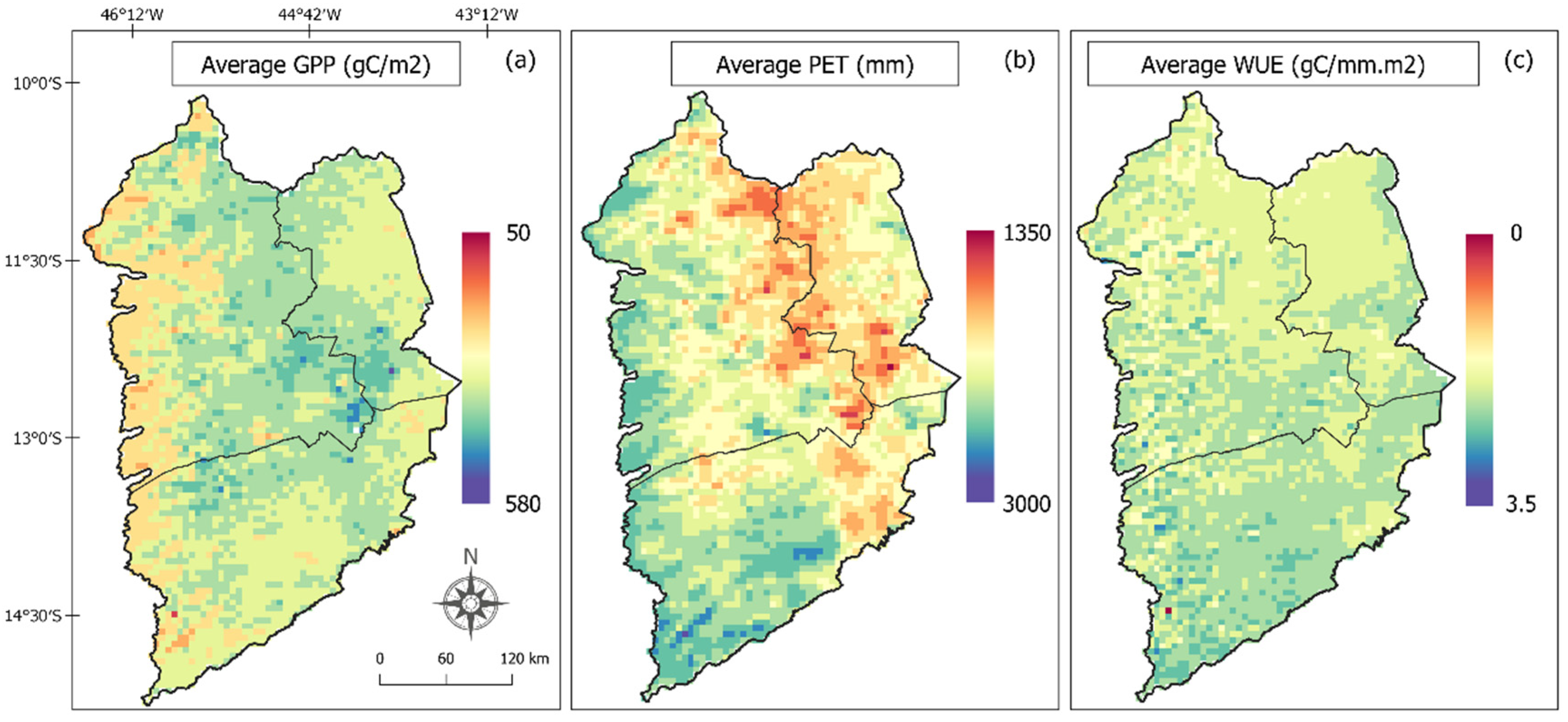
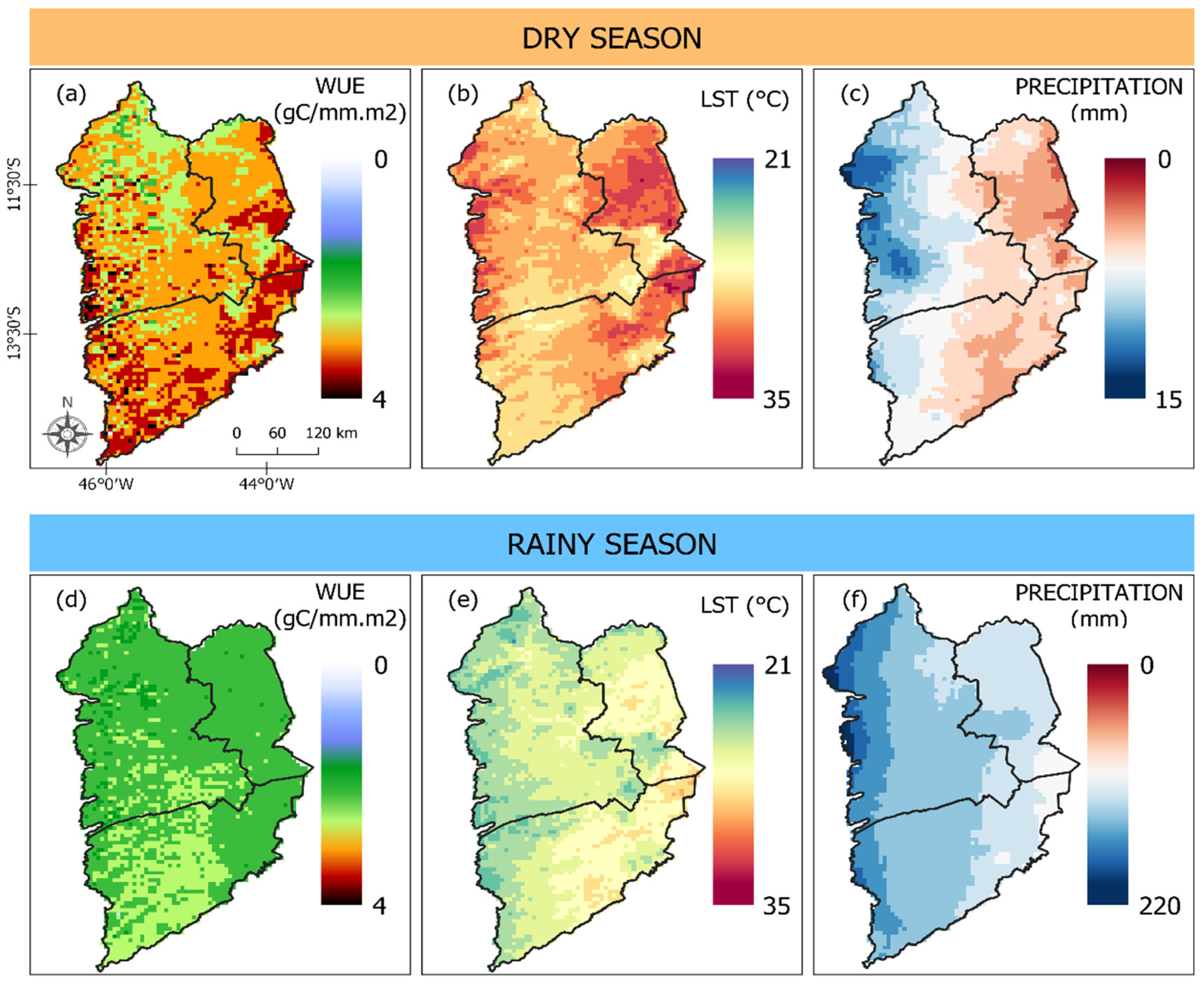
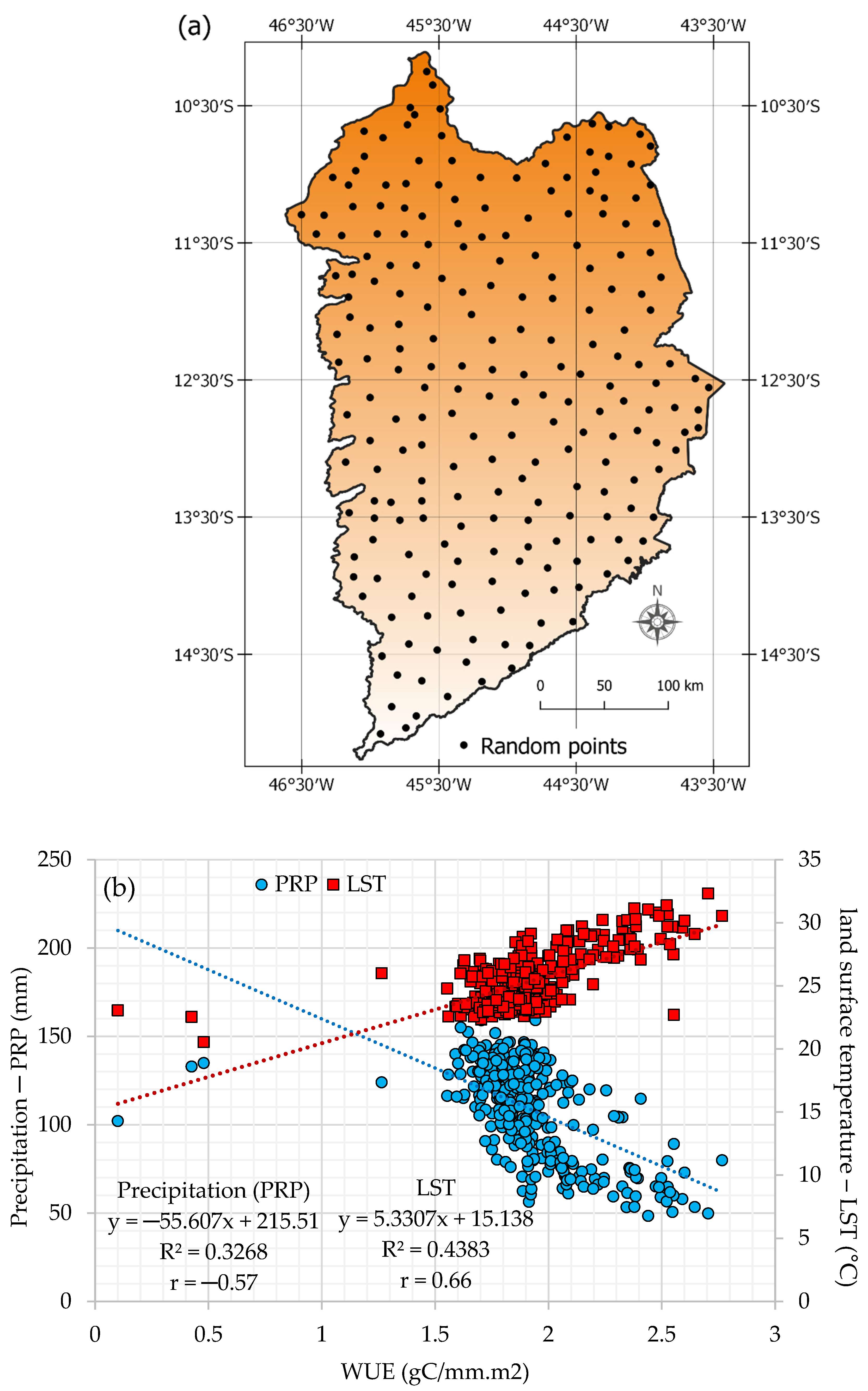
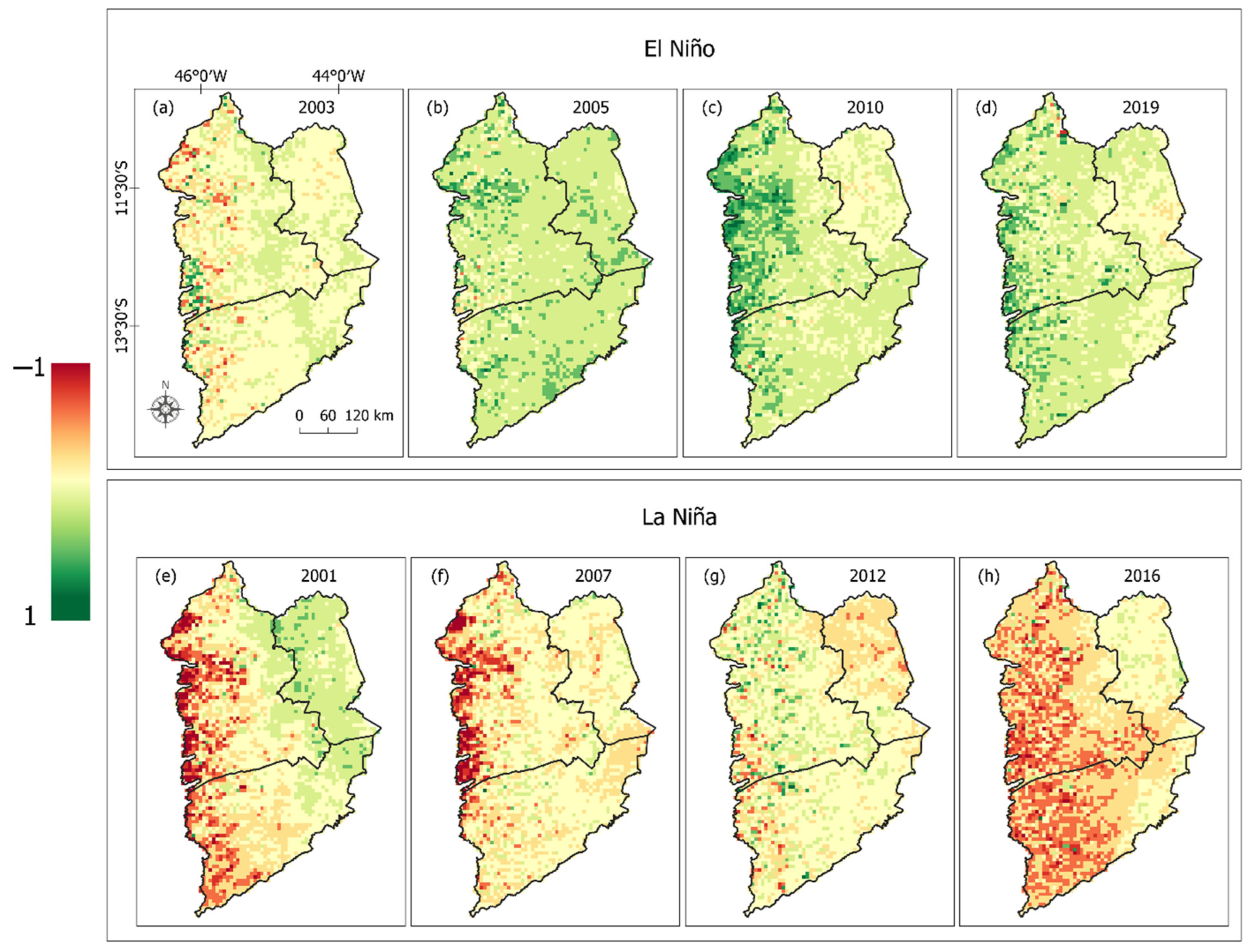
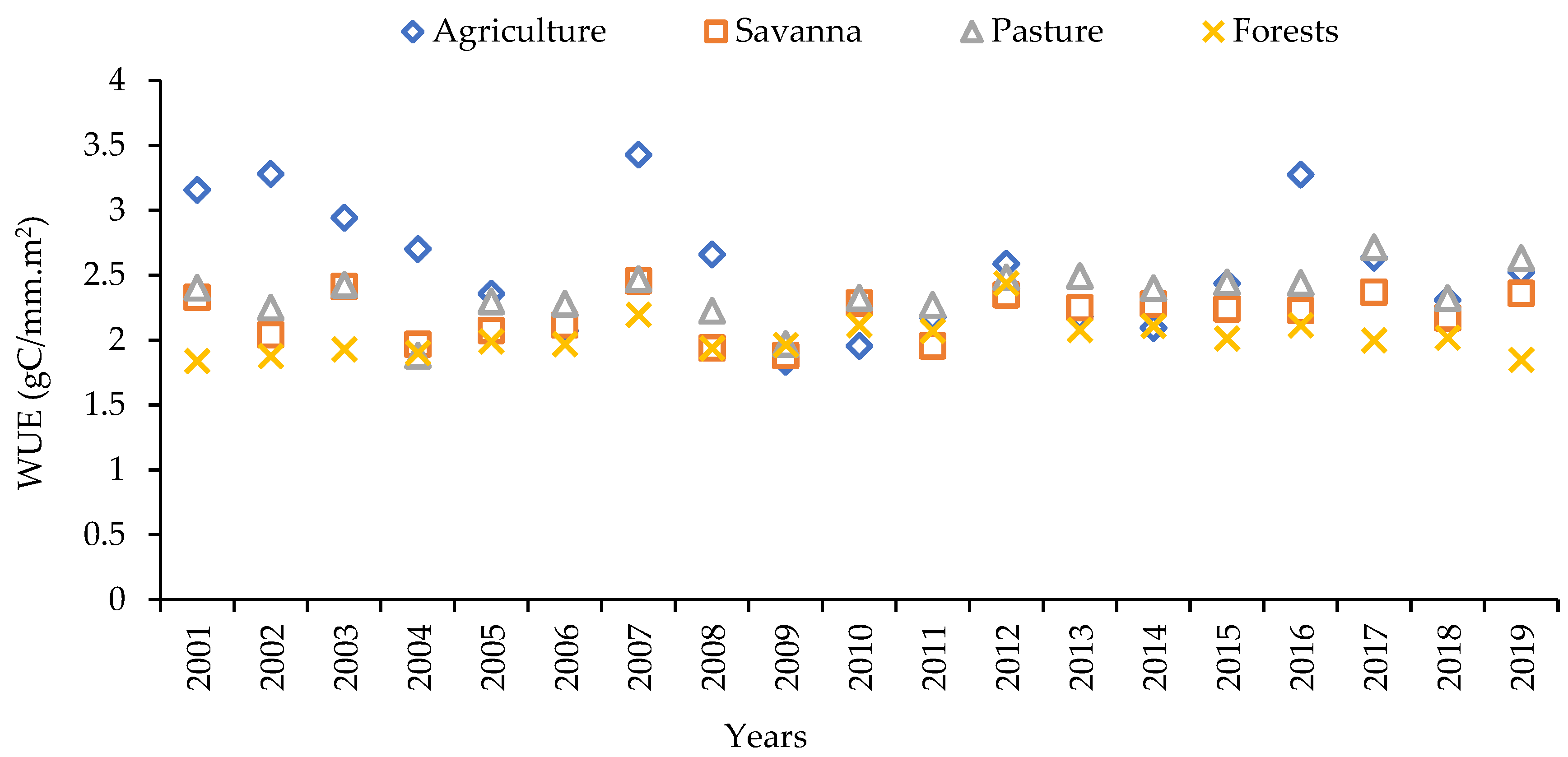
| Coefficients | Interpretation |
|---|---|
| 1.00 (−1.00) | Perfect positive (negative) correlation |
| 0.80 (−0.80) ≤ r ≤ 1.00 (−1.00) | Very high positive (negative) correlation |
| 0.60 (−0.60) ≤ r ≤ 0.80 (−0.80) | High positive (negative) correlation |
| 0.40 (−0.40) ≤ r ≤ 0.60 (−0.60) | Moderate positive (negative) correlation |
| 0.20 (−0.20) ≤ r ≤ 0.40 (−0.40) | Low positive (negative) correlation |
| 0 ≤ r ≤ 0.20 (−0.20) | Very low positive (negative) correlation |
| 0 | Null correlation |
| Events | Years |
|---|---|
| El Niño | 2002–2003, 2006–2007, 2009–2010, 2015–2016, 2018–2019 |
| La Niña | 1999–2001, 2005–2006, 2007–2009, 2010–2012, 2017–2018 |
| Minimum | Median | Mean | Maximum | |
|---|---|---|---|---|
| WUE (Dry period) | 1.95 | 2.83 | 2.84 | 3.69 |
| WUE (Rainy period) | 1.50 | 1.89 | 1.92 | 2.36 |
| Precipitation (Dry period) | 2.72 | 5.60 | 6.30 | 12.42 |
| Precipitation (Rainy period) | 102.90 | 136.90 | 136.90 | 180.10 |
| LST (Dry period) | 26.96 | 30.09 | 30.14 | 33.30 |
| LST (Rainy period) | 23.02 | 25.75 | 25.91 | 28.62 |
Publisher’s Note: MDPI stays neutral with regard to jurisdictional claims in published maps and institutional affiliations. |
© 2022 by the authors. Licensee MDPI, Basel, Switzerland. This article is an open access article distributed under the terms and conditions of the Creative Commons Attribution (CC BY) license (https://creativecommons.org/licenses/by/4.0/).
Share and Cite
Santiago, D.d.B.; Barbosa, H.A.; Correia Filho, W.L.F.; Oliveira-Júnior, J.F.d.; Paredes-Trejo, F.; de Oliveira Buriti, C. Variability of Water Use Efficiency Associated with Climate Change in the Extreme West of Bahia. Sustainability 2022, 14, 16004. https://doi.org/10.3390/su142316004
Santiago DdB, Barbosa HA, Correia Filho WLF, Oliveira-Júnior JFd, Paredes-Trejo F, de Oliveira Buriti C. Variability of Water Use Efficiency Associated with Climate Change in the Extreme West of Bahia. Sustainability. 2022; 14(23):16004. https://doi.org/10.3390/su142316004
Chicago/Turabian StyleSantiago, Dimas de Barros, Humberto Alves Barbosa, Washington Luiz Félix Correia Filho, José Francisco de Oliveira-Júnior, Franklin Paredes-Trejo, and Catarina de Oliveira Buriti. 2022. "Variability of Water Use Efficiency Associated with Climate Change in the Extreme West of Bahia" Sustainability 14, no. 23: 16004. https://doi.org/10.3390/su142316004
APA StyleSantiago, D. d. B., Barbosa, H. A., Correia Filho, W. L. F., Oliveira-Júnior, J. F. d., Paredes-Trejo, F., & de Oliveira Buriti, C. (2022). Variability of Water Use Efficiency Associated with Climate Change in the Extreme West of Bahia. Sustainability, 14(23), 16004. https://doi.org/10.3390/su142316004









